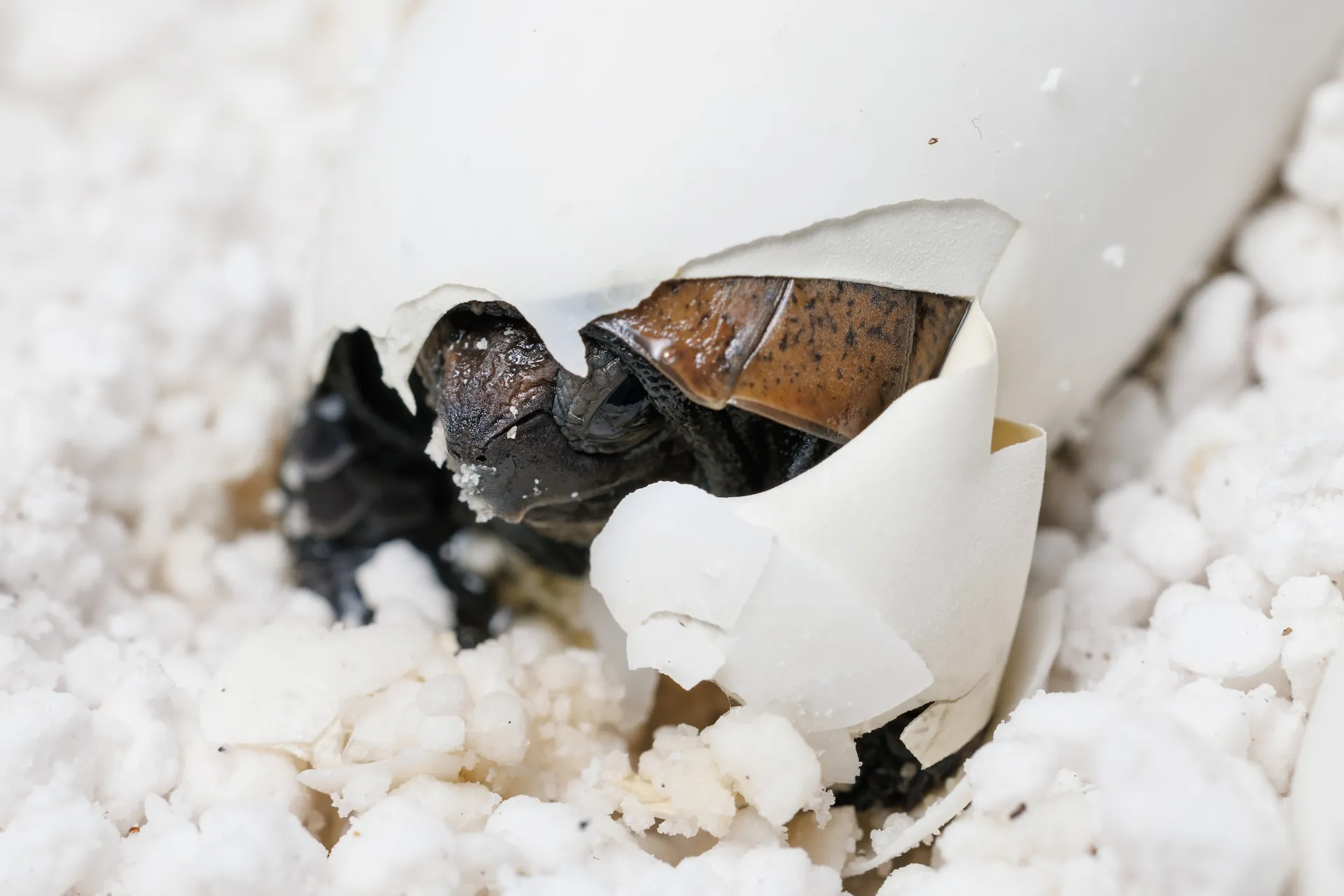Chattanooga, Tenn. (March 21, 2024) – Like many Southeast Asian turtles, life in the wild is decidedly difficult for the critically endangered Arakan Forest Turtle.
Rampant habitat destruction has reduced the range for this forest-dwelling reptile to just a narrow, mountainous strip of Myanmar and Bangladesh. Combined with the unwelcome attention of illegal traffickers supplying the pet trade and food markets, the wild population of Arakan Forest Turtles has decreased by 80 percent over the last three generations — about 75 years — according to the International Union for Conservation of Nature (IUCN).
Given the species’ profoundly unlucky streak, the Tennessee Aquarium is especially excited to offer a glimmer of celebratory hope for the future of Arakan Forest Turtles in the form of seven newly arrived hatchlings. These rambunctious little tykes recently emerged with 100% success from a clutch of seven eggs laid by adults housed in off-exhibit systems at the Aquarium.
This represents the largest group of Arakan Forest Turtles to ever hatch at a facility accredited by the Association of Zoos and Aquariums (AZA). The next largest clutch to emerge successfully was a group of five at Zoo Atlanta in 2013.
“The fact that all seven eggs hatched is really great,” says Aquarium Herpetology Coordinator Bill Hughes. “Every individual that hatches is a small victory because it’s one more in the population in human care when their population in the wild is declining.”
Unlike some imperiled species, Arakan Forest Turtles are housed at relatively few AZA-accredited aquariums, zoos, or wildlife centers. Nationwide, only six facilities care for populations of Arakan Forest Turtles.
AZA Species Survival Programs (SSP) manage a species across every facility where it is cared for by making recommendations for relocation of individuals and breeding pairings to ensure the overall population’s health. Hughes managed the SSP for the Arakan Forest Turtle from its inception in 2011 until the program ended in 2023 due to the decline in facilities that worked with them. He continues to maintain the Arakan Forest Turtle studbook, a database documenting all births and deaths wherever the species is cared for.
The arrival of the lucky seven continues the Aquarium’s streak of success, adding to the population in human care. Last year, the Aquarium hatched its first-ever Arakans — a pair that emerged from a clutch of six eggs. These hatchlings represented the first addition to the population in human care since 2017.
Thanks to the Aquarium’s reproductive success, the population of Arakan Forest Turtles in AZA facilities has increased by 27% in the last year alone. This growth gives Hughes hope to potentially broaden the number of facilities working with the species in the future.
Having a viable population spread across zoos and aquariums is important. Then, if something happened to the last few in the wild, they wouldn’t be totally extinct,” he says. “If we hatch enough babies — hopefully, we do this again next year and have some surplus — we can send them out to other zoos and get them excited about these guys again.”
Despite their abundance of energy and mobility in the early days after emerging from their eggs, Hughes kept close tabs on the seven hatchlings for the first few days. After giving them time to come to grips with life outside the shell, the seven hatchlings will join dozens of other tiny turtles in a publicly viewable turtle nursery in the River Journey building.
By exhibiting these tiny representatives of an increasingly rare and embattled species, Hughes hopes to forge connections between guests and an animal they would otherwise be unlikely to encounter.
“This is a species that you probably don’t know exists, except that we hatched them here,” he says. “You can actually see what they look like moving around rather than just as a picture in a book. For me, at least, that’s very exciting.
“I love books, and I love looking at pictures of rare things in books, but it’s not quite the same effect as seeing one moving around. And actually hatching them ourselves is even better.”
=============================================================
Wildlife trafficking is an international crisis that has devastating impacts to both animals and humans. Wildlife trafficking, which is fueled by an unprecedented demand for wildlife and wildlife products, is a significant threat to wildlife, driving many threatened and endangered animal species to the brink of extinction. Wildlife experts have confirmed that if we don’t act quickly, trafficking will wipe out many endangered species in our lifetime.
Learn more about the animals most at risk, and what you can do to save them through the Wildlife Trafficking Alliance.
